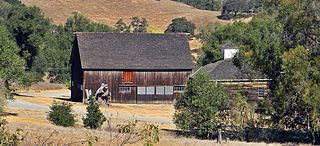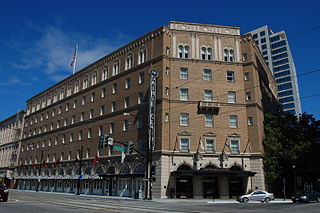
Mission San Xavier del Bac is a historic Spanish Catholic mission located about 10 miles (16 km) south of downtown Tucson, Arizona, on the Tohono O'odham Nation San Xavier Indian Reservation. The mission was founded in 1692 by Padre Eusebio Kino in the center of a centuries-old settlement of the Sobaipuri O'odham, a branch of the Akimel or River O'odham located along the banks of the Santa Cruz River. The mission was named for Francis Xavier, a Christian missionary and co-founder of the Society of Jesus in Europe. The original church was built to the north of the present Franciscan church. This northern church or churches served the mission until it was razed during an Apache raid in 1770.

The Peralta Adobe, also known as the Luis María Peralta Adobe or the Gonzales-Peralta Adobe, is the oldest building in San Jose, California. The adobe was built in 1797 by José Manuel Gonzeles, one of the founders of San Jose, and is named after Luis María Peralta, its most famous resident.

The Rancho San Andrés Castro Adobe is a historically and architecturally significant house located in the Pájaro Valley, California. The two-story Rancho San Andrés Castro Adobe is a historic rancho hacienda that was built between 1848 and 1849.
Rancho San Antonio, also known as the Peralta Grant, was a 44,800-acre (181 km2) land grant by Governor Pablo Vicente de Solá, the last Spanish governor of California, to Don Luís María Peralta, a sergeant in the Spanish Army and later, commissioner of the Pueblo of San José, in recognition of his forty years of service. The grant, issued on August 3, 1820, embraced the sites of the cities of San Leandro, Oakland, Alameda, Emeryville, Piedmont, Berkeley, and Albany.
Luis María Peralta was a Spanish-born Californio ranchero and soldier in the Spanish Army. Peralta received Rancho San Antonio, one of the largest of the rancho grants in California, covering 44,800-acre (181 km2) that encompassed most of the East Bay region of the Bay Area in Northern California.

Monterey State Historic Park is a historic state park in Monterey, California. It includes part or all of the Monterey Old Town Historic District, a historic district that includes 17 contributing buildings and was declared a National Historic Landmark in 1970. The grounds include California's first theatre, and the Monterey Custom House, where the American flag was first raised over California.

Don Guillermo Castro, born in 1809 in Spanish Alta California, was a Californio ranchero, military officer, local justice of the peace and surveyor who once owned vast land holdings in Alameda County. He is the namesake of the unincorporated community of Castro Valley, California and his land included most of the modern City of Hayward, California.

Rancho Petaluma Adobe is a historic ranch house in Sonoma County, California. It was built from adobe bricks in 1836 by order of Mariano Guadalupe Vallejo. It was the largest privately owned adobe structure built in California and is the largest example of the Monterey Colonial style of architecture in the United States. A section of the former ranch has been preserved by the Petaluma Adobe State Historic Park and it is both a California Historic Landmark and a National Historic Landmark. The Rancho Petaluma Adobe State Historic Park is located on Adobe Road on the east side of the present-day town of Petaluma, California.

The Sánchez Adobe Park, home to the Sánchez Adobe, is located in Pacifica, California, at 1000 Linda Mar Boulevard, on the north bank of San Pedro Creek, approximately 0.91 miles (1,470 m) from the Pacific Ocean in Linda Mar Valley. The 5.46-acre (2.21 ha) county park, established in 1947 contains the Sanchez Adobe Historical site, designated a National Register Historical District in 1976 and is California registered landmark 391.
Hermenegildo Ignacio Peralta was a Spanish settler in California, the eldest son of Luís María Peralta.

Olompali State Historic Park is a 700-acre (2.8 km2) California State Park in Marin County, California. It is constituted of the former Rancho Olómpali and was the site of the famed Battle of Olómpali during the Bear Flag Revolt. Rancho Olómpali was purchased by the Californian government in 1977, which turned it into a public park.

Mission San Cayetano de Calabazas, also known as Calabasas, is a Spanish Mission in the Sonoran Desert, located near present-day Tumacacori, Arizona, United States.

The Westin San Jose, housed in the historic Sainte Claire Hotel, is a six-story landmark hotel in Downtown San Jose, California, United States. Built in 1926, it is listed on the National Register of Historic Places and one of the city's most recognized architectural landmarks.

The José Castro House, sometimes known as the Castro-Breen Adobe, is a historic adobe home in San Juan Bautista, California, facing the Plaza de San Juan. The Monterey Colonial style house was built 1838-41 by General José Antonio Castro, a former Governor of Alta California. It was later sold to the Breen family, who lived there until 1933, when the house became a museum as part of San Juan Bautista State Historic Park.

José Joaquín Estudillo was a Californio statesman and ranchero who served as the 2nd Alcalde of San Francisco. A member of the prominent Estudillo family of California, he is also considered the founder of the city of San Leandro.

The Larkin House is a historic house at 464 Calle Principal in Monterey, California. Built in 1835 by Thomas O. Larkin, it is claimed to be the first two-story house in all of California, with a design combining Spanish Colonial building methods with New England architectural features to create the popular Monterey Colonial style of architecture. The Larkin House is both a National and a California Historical Landmark, and is a featured property of Monterey State Historic Park.

La Casa Alvarado, also known as the Alvarado Adobe, is a historic adobe structure built in 1840 and located on Old Settlers Lane in Pomona, California. It was declared a historic landmark in 1954 and added to the National Register of Historic Places in 1978.

Casa Peralta is a historic home located at 384 W. Estudillo Ave. in San Leandro, California. The home was built in 1901 by Ludovino Peralta and originally had a Colonial Revival design. The original design included Tuscan columns, modillions, and a dentillated cornice, features which remain a part of the home. After Ludovino died, the home passed to her sister Maria and later to her niece Hermania Peralta Dargie. In 1927, Hermania hired Captain Antonio Martin to redesign the house in the style of the Peralta family's estate in Spain. Martin's design added a formal garden with a fountain, a front porch with tiles depicting scenes from Don Quixote, and a four-story tower.

The Stevenson House, is a historic two-story Spanish Colonial style building located at 530 Houston Street in Monterey, California. It was a boarding house called the French Hotel, built circa 1836. The Scottish author Robert Louis Stevenson lived there in 1879, writing and courting his future wife. It is now a museum and property of the Monterey State Historic Park. The building was listed on the National Register of Historic Places on January 7, 1972. The building is also listed as a California historical landmark #352.

The Roberto-Suñol Adobe, also known as the Roberto Adobe & Suñol House is a historic adobe dwelling located in San Jose, California, within the former Rancho Los Coches. The house was built in 1836 by Roberto Balermino, fourteen years before California's admittance to the Union. Then in 1847, Spanish-born Antonio Suñol built the adjoining brick Suñol House. The California Pioneers of Santa Clara County, a non-profit organization, obtained this property with the intention of establishing a no-cost museum for the public's benefit. The adobe is a California Historical Landmark and was placed on the National Register of Historic Places listings in Santa Clara County, California on March 17, 1977.




















